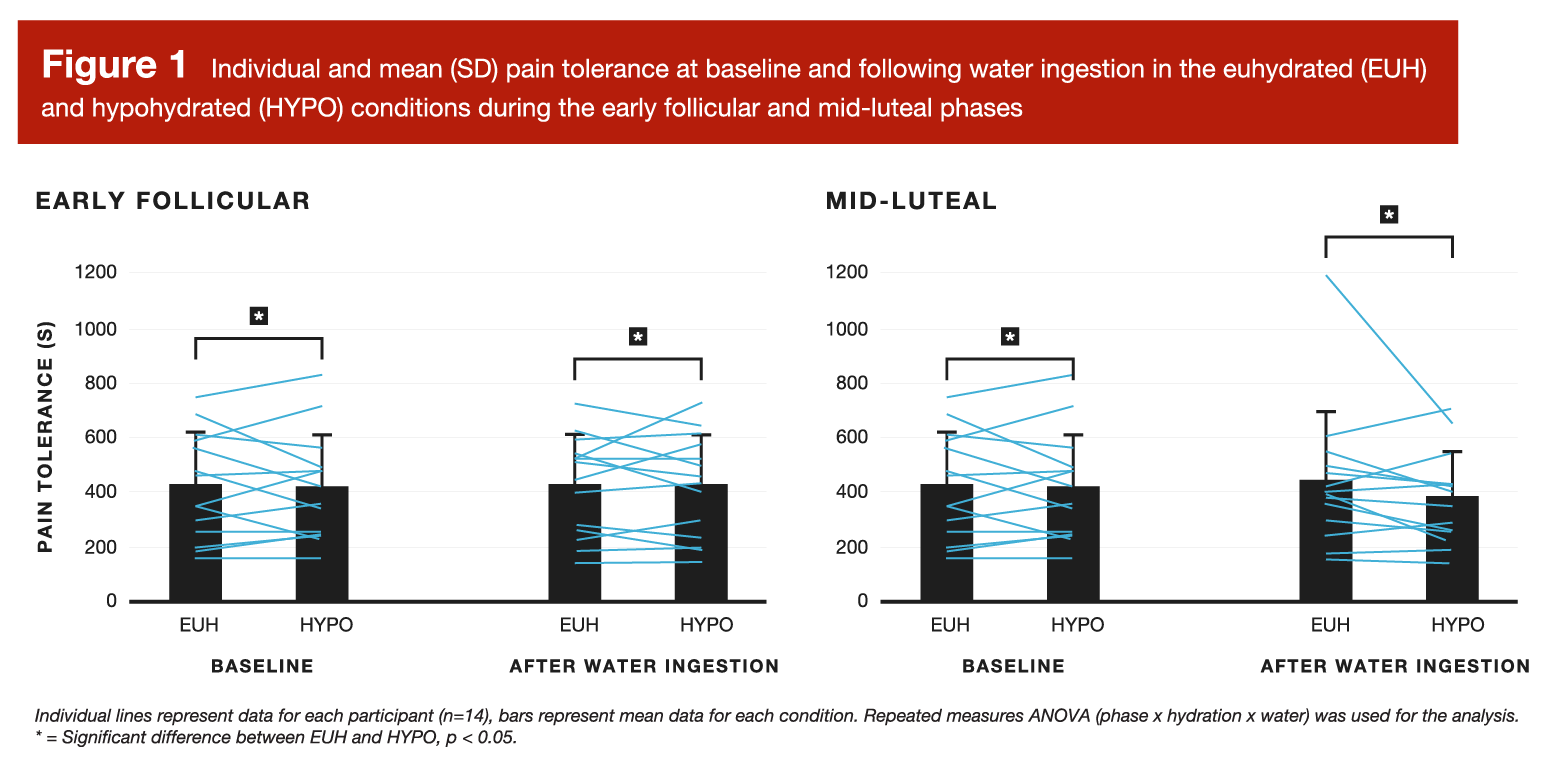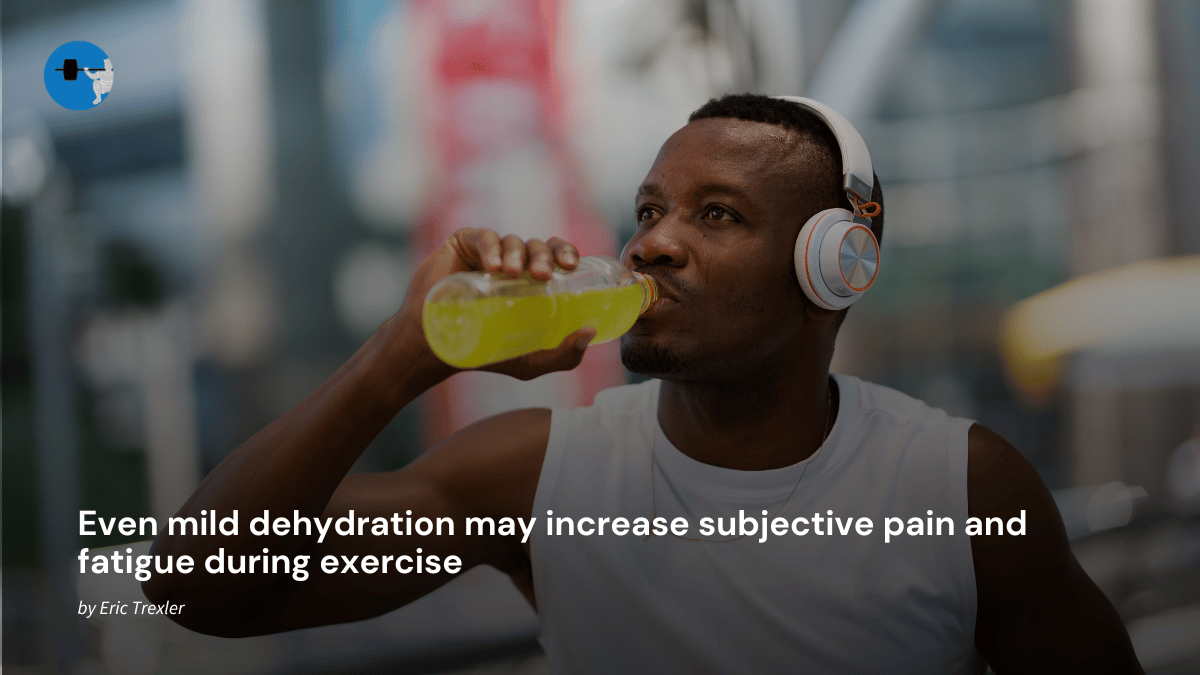Research has suggested that even mild hypohydration (~1% reduction of body mass due to water loss) increases pain sensitivity during the cold pressor test, which involves dunking your hand into ice water to acutely induce pain. While the cold pressor test may not be perfectly reflective of the type of pain experienced during vigorous exercise, other research has reported that dehydrated athletes reported lower subjective vigor and higher ratings of fatigue and pain compared to euhydrated athletes during an ultra-endurance cycling event. Nonetheless, ultra-endurance events are still quite different from the repetitive pattern of forceful muscle actions associated with resistance exercise. Furthermore, much of the research exploring pain sensitivity and hypohydration has been carried out using male samples. This is important because hormones that fluctuate throughout the menstrual cycle influence fluid balance. Given that total body water fluctuates throughout the menstrual cycle, it’s possible that susceptibility to mild hypohydration and associated increases in pain sensitivity may vary across the menstrual cycle.
The presently reviewed study investigated the impact of mild hypohydration on pain sensitivity in a crossover trial, with two visits occurring in the early follicular phase, and the other two visits occurring in the mid-luteal phase of the menstrual cycle. One visit within each menstrual phase was completed in a euhydrated state, and the other was completed in a hypohydrated state. Hypohydration was induced by restricting intake of fluids and foods with high water content for 24 hours prior to hypohydration visits; this resulted in a weight reduction of ~0.9% of body mass, and hydration status was verified via serum osmolality and urine specific gravity testing.
The study was completed by 17 healthy, eumenorrheic women who had not used hormonal contraceptives within the prior six months (age: 28 ± 8 years; height: 1.63 ± 0.07 meters; weight: 65.0 ± 10.8 kg). Pain was induced by an ischemic pain test using the Submaximal Effort Tourniquet Procedure. A pneumatic cuff was applied to the participant’s upper arm (just above the elbow joint), and the arm was raised for 30 seconds to promote venous drainage. After that, the cuff was inflated to a pressure of 250mmHg (which is generally sufficient for arterial occlusion), the arm was lowered to rest on a table with the elbow fixed at a 90 degree angle, and participants completed 25 gripping actions at 30% of their maximal hand grip force. Each contraction was held for 2 seconds, followed by 2 seconds of rest, and subjective post-exercise pain was assessed using a visual analog scale. After the contractions, participants rested (with the cuff still applied and inflated) until they could no longer tolerate the ischemic pain and terminated the ischemia test. To assess the impact of acute water ingestion, participants consumed water (5mL/kg of baseline body mass) after the first ischemia test, rested for 30 minutes, and repeated the testing as described.
Results indicated that mild hypohydration (~0.9% loss of body mass) increased self-reported post-exercise pain sensitivity, as measured by a visual analog scale, by an average of 13%. Hypohydration also increased post-exercise pain unpleasantness by an average of 12%, while reducing pain tolerance (the duration of the ischemic test, prior to volitional termination) by about 8%. In all three cases, findings were statistically significant (p < 0.05). Menstrual cycle phase significantly impacted thirst ratings (with higher thirst ratings observed in the mid-luteal phase), but did not significantly impact pain outcomes or significantly modify the relationship between hypohydration and pain outcomes. Hypohydration significantly increased thirst ratings, and acute water ingestion significantly reduced thirst, with a large effect observed in the hypohydrated condition compared to the euhydrated condition. Nonetheless, acute water ingestion did not significantly influence pain tolerance, and unexpectedly led to increases in ratings of pain intensity and pain unpleasantness. Group-level and individual-level pain tolerance data are presented in Figure 1; while there does appear to be one noteworthy outlier for this outcome, I don’t suspect this observation meaningfully impacts our interpretation of the collective results from this study.

Within the evidence-based fitness space, I think there’s an interesting discrepancy between how we tend to discuss factors that have direct versus indirect effects on our progress. For example, you can find countless articles and discussions exploring every detail of protein intake: amino acid profile, digestibility, absorption speed, frequency, timing, daily targets, and so on. The same can be said for carbohydrates, with plenty of discussion surrounding starches, sugars, fibers, glycemic index, glycemic load, peri-workout timing, relationships between exercise intensity and carbohydrate demands, and so on. People assess the adequacy of their protein intake based on hypertrophy optimization, and assess the adequacy of their carb intake based on performance optimization; the conversation is about maximization and optimization, not the prevention of malnutrition symptoms.
There’s a huge divergence when we shift our focus toward the boring stuff, like micronutrients and hydration. On one hand, this divergence could be viewed as a positive thing; I generally discourage people from obsessing over small stuff, and the inclination to get wrapped up in the minor details of nutrition is pretty pervasive. I think a lot of strategies that fall under the “biohacking” umbrella promote an unjustified degree of fixation on extremely minor details of nutrition, and often put forth speculative solutions with limited evidence to support practically meaningful effects. On the other hand, I don’t think we should necessarily conclude that your vitamin C intake is perfect because you don’t have scurvy yet, or that your hydration level is adequate because you haven’t noticed any overt symptoms of severe dehydration. There’s ample justification for the suggestion that regular exercisers should aim for micronutrient intakes that optimize health and function, rather than bare minimums to stave off severe malnutrition, and hydration should be approached in a similar manner.
A growing body of research, including the presently reviewed study, indicates that even mild hypohydration can significantly increase pain perception across a broad range of pain-inducing tasks, including (but not limited to) tasks involving exercise. Based on the evidence available, this observation seems to apply irrespective of menstrual cycle phase or biological sex. In addition, hypohydration (3.2% weight loss) was found to significantly increase fatigue perception following leg extension exercise and to significantly reduce repetitions (by about 28%) completed during a leg extension test using 85% of maximal voluntary isometric contraction torque. In the same study, isometric peak torque was not significantly impacted by hypohydration; however, as Greg noted in a previous MASS Research Review article, it’s common for studies to use simple, single-joint muscle actions when assessing the impact of hypohydration on maximal strength. Hypohydration has generally been found to negatively impact tasks that involve endurance, repeated efforts, and technical sport-specific skills; as a result, I suspect that even mild hypohydration could negatively impact the repeated actions observed in a typical resistance training session or the highly skilled movements involved in competitive strength sports. In addition, the impact of hypohydration on subjective indices of mood state, fatigue, and pain may inflate perceived exertion, which could potentially have a noteworthy impact on autoregulated training programs that rely on ratings of perceived exertion to dictate program changes.
In summary, there are plenty of reasons to prioritize hydration in order to optimize training and performance. In addition, research suggests that mild hypohydration is extremely common among athletes, and that drinking to merely attenuate thirst is often an insufficient strategy for replacing sweat losses from exercise. As a result, it makes sense to allocate a little bit of attention to hydration status if your aim is to optimize your performance (and subjective experience) in the gym. Fortunately, supporting optimal hydration status isn’t particularly complicated or challenging.
For the general population, fluid intake guidelines typically recommend ~4 liters per day for males and ~3 liters per day for females. The discrepancy between sexes is largely related to differences in body size and fat-free mass, but these rough recommendations are typically suitable for the general population. It’s also important to recognize that these values reflect total fluid intake; for most people on balanced diets, around 20% of total fluid intake comes from food, with the remaining 80% coming from beverages. It’s difficult to make one-size-fits-all hydration recommendations, as hydration can be hard to quantify in real-world settings, and sweat rates vary substantially based on environment, exercise habits, and inter-individual differences. My personal approach is to begin with 3-4 liters per day (per common guidelines for the general population), while aiming to maintain a suitable urine color throughout the entire day. If you’re doing a ton of exercise in the heat, spending much of the day in a hot environment, or you just have a naturally high sweat rate, then 3-4 liters might not get the job done, and that’ll become quickly apparent based on your thirst response and the color and volume of your urine.
Note that “throughout the entire day” is an important detail in the hydration conversation; there is a temporal component to hydration status, and drinking a gallon of water per day doesn’t do much good if you’re staring at the jug most of the day, then chugging it at night to hit your daily target. In such a scenario, you spent most of your day dehydrated, despite achieving a total daily intake of one gallon. Best practices would involve making an effort to consume at least a glass or two of water upon waking, and maintaining euhydration throughout the entire day rather than playing “catch-up” in the evening. Similarly, it’s not a bad idea to have another glass or two of water prior to exercise, as sweat losses are likely to accelerate when exercise is initiated. The magnitude of sweat loss during exercise will vary substantially from person to person and scenario to scenario, but an easy target to support adequate hydration is to consume enough fluid to replace sweat losses. If you’re losing (or gaining) a significant amount of weight from before your workout to after, you’ll want to revise your hydration strategy in order to maintain approximate weight stability. Finally, if you’re losing considerable amounts of sweat during exercise, you might also consider adding some electrolytes to your beverage, as we lose both water and electrolytes in sweat. However, this strategy probably isn’t particularly relevant unless you’re doing very high-volume endurance exercise, training in a very hot environment, or consuming a relatively electrolyte-depleted diet.
In conclusion, evidence suggests that mild hypohydration is common among athletes (in addition to the general population), and that it can increase subjective pain and fatigue during exercise while impairing performance for a variety of exercise tasks. Most individuals are able to maintain an euhydrated state with 3-4 liters per day of water intake, but individualization is important due to differences in sweat losses from person to person. It’s not particularly hard to monitor and maintain euhydration, but mild hypohydration may go entirely unnoticed if you aren’t paying attention to it. Best practices for optimizing hydration status involve prioritizing fluid throughout the entire day (which would include making an effort to consume some fluid shortly after waking), monitoring thirst perception, urine output, and urine color throughout the day, consuming some pre-exercise fluid to promote adequate hydration during your workout, and replacing enough fluid during and immediately after your workout to maintain a relatively stable body weight. By implementing these very simple approaches, you can individualize your fluid intake to meet your hydration needs in a manner that is easy and virtually free of cost.
Note: This article was published in partnership with MASS Research Review. Full versions of Research Spotlight breakdowns are originally published in MASS Research Review. Subscribe to MASS to get a monthly publication with breakdowns of recent exercise and nutrition studies.




